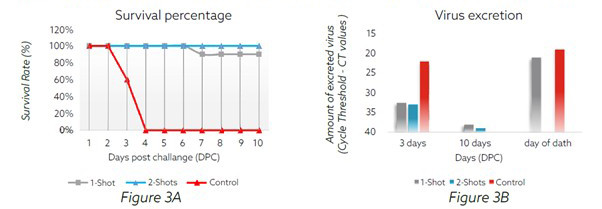December 5, 2025 | 20:29 GMT +7
December 5, 2025 | 20:29 GMT +7
Hotline: 0913.378.918
December 5, 2025 | 20:29 GMT +7
Hotline: 0913.378.918
Highly Pathogenic Avian Influenza viruses have been found in the yolk and albumen of eggs from infected chickens, turkeys and quails. Complementary to biosecurity, vaccination has become the primary control measure used to minimise losses . The objective of this study was to evaluate the efficacy of Mefluvac H5 Plus 8 against circulating HPAI H5N6 and H5N8 viruses isolated in Vietnam, adopting 2 vaccination regimes.
Avian influenza viruses type A are members of the family Orthomyxoviridae, being structured with a negative-sense, single-strand, segmented genomic RNA. The outer viral coat is characterised by the presence of two important antigenic fractions, the hemagglutinin (HA) and neuraminidase (NA) proteins. Highly pathogenic avian influenza (HPAI) viruses can be originated from certain LPAI viruses while these are circulating in poultry flocks. HPAI viruses can cause mortality in 100% of the flock, and trigger epidemics that may spread rapidly, devastate the poultry industry and result in severe trade restrictions.
Animals: 3-week-old commercial chickens were purchased from a local farm in Vietnam with no avian influenza (AI) vaccination history. Before the experiments, birds were randomly checked for H5 antibodies and avian influenza virus (AIV) by RT-PCR test (10% of birds), obtaining negative results.
Vaccine: Mefluvac H5 Plus 8
Challenge viruses:
Used HI antigens: 3 weeks after each vaccine shot (at age of 6 and 9 weeks-old), all vaccinated birds were tested for antibody titers (H5 vaccine-homologous antigens).
Monitoring: Challenged chickens were monitored for 10 days after inoculation and scored for clinical signs in accordance with the WOAH guidelines.
Clinical protection and viral load reduction
The described figures (2A – 2B and 3A – 3B) concisely show i) the survival rate of vaccinated birds against virulent influenza viruses, and ii) the ability of reducing viral excretion; both considered important criteria when evaluating the efficacy of AI vaccines. The viral load was investigated by the analysis of oro-pharyngeal swabs after challenge.
Figure 2A and 2B – Challenge by HPAI H5N8 clade 2.3.4.4b at day 21 post-vaccination.

In the present study, we found that a vaccination regime with Mefluvac H5 Plus 8 inactivated vaccine triggered a strong immune response in experimental birds with homologous HI antibody titer of 6.6 log2 when used with 1-shot regime and 8.9 log2 when used with 2-times vaccination regime. After challenge with H5N8 clade 2.3.4.4b virus, Mefluvac H5 Plus 8 vaccine conferred a protective rate of 90% with both vaccination regimes: 1-shot and 2-shots. After challenge with H5N6 clade 2.3.4.4g virus, Mefluvac H5 Plus 8 vaccine conferred a protective rate of 90% for 1-shot vaccinated chickens and 100% protection for those birds receiving the 2-times vaccination regime.
(Poultryworld)

(VAN) After three years, Project FST/2020/123 collected approximately 3,000 insect specimens, classified them into about 50 morphological groups, and identified around 40 species, including several new species.
/2025/12/01/0509-2-175427_206.jpg)
(VAN) Emission-reducing coffee areas in Lam Dong have entered the new crop with stable yields, improved quality, and a remarkably enhanced cultivation environment.

(VAN) The Institute of Agricultural Sciences for Southern Vietnam (IAS) marked its 100th anniversary in Ho Chi Minh City, celebrating a century of growth as a leading institute contributing significantly to Viet Nam’s agricultural development.

(VAN) An increasing number of livestock farms are using biogas generators to create a source of renewable electricity, helping to save costs and mitigate environmental pollution.

(VAN) Small changes in rice cultivation, from irrigation methods and straw collection to input management, are paving a new way for Vietnam's agriculture in the journey toward emission reduction.

(VAN) With the project of converting biogas into renewable electricity, Australia is both helping pig farms reduce their energy costs by up to 25% and contributing to environmental protection.
![Hue aims for Net Zero: [1] Initial steps from green transportation](https://t.ex-cdn.com/nongnghiepmoitruong.vn/608w/files/huytd/2025/11/28/0853-anh-6-giao-thong-xanh-hue-094717_940-153724.jpg)
(VAN) For sustainable development, Hue City is implementing many solutions to promote green transportation, which is an important initial step on the journey to building a Net Zero Hue.